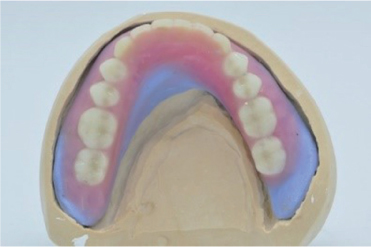J Korean Acad Prosthodont.
2019 Oct;57(4):350-355. 10.4047/jkap.2019.57.4.350.
Complete denture making in a patient of partial glossectomy using polished surface impression taking and direct metal laser sintering method: A case report
- Affiliations
-
- 1Department of Prosthodontics, College of Denistry, Chosun University, Gwangju, Republic of Korea. lkj1998@chosun.ac.kr
- KMID: 2461141
- DOI: http://doi.org/10.4047/jkap.2019.57.4.350
Abstract
- For the success of complete denture, three essential requirements such as retention, stability and support are needed. Moreover, due to the absorption of residual ridge and scarring due to the surgery, when making a complete denture, which is difficult to form the mandibular lingual margins, various considerations such as the arrangement of the Non-anatomical dl non-anatomical teeth, the polished surface impression, the internally weighted metal framework and the use of the denture adhesive cream are necessary. In this case report, the patient has a severely resorbed edentulous ridge from severe periodontitis and has some soft tissue problems after the glossectomy due to tongue cancer. To obtain additional retention and stability, some trials such as polished surface impression taking, internally weighted metal insertion and minimal pressure impression were done for the better result. Moreover To make a metal framework that precisely shapes the desired three-dimensional shape and reduces the complicated process, minimal pressure impression method and direct metal laser sintering technique were used.
MeSH Terms
Figure
Reference
-
1. Bencharit S, Schardt-Sacco D, Border MB, Barbaro CP. Full mouth rehabilitation with implant-supported prostheses for severe periodontitis: a case report. Open Dent J. 2010; 4:165–171.
Article2. Doundoulakis JH, Eckert SE, Lindquist CC, Jeffcoat MK. The implant-supported overdenture as an alternative to the complete mandibular denture. J Am Dent Assoc. 2003; 134:1455–1458.
Article3. MacEntee MI, Walton JN. The economics of complete dentures and implant-related services: a framework for analysis and preliminary outcomes. J Prosthet Dent. 1998; 79:24–30.
Article4. Jacobson TE, Krol AJ. A contemporary review of the factors involved in complete dentures. Part II: stability. J Prosthet Dent. 1983; 49:165–172.
Article5. Pleasure MA. Anatomic versus nonanatomic teeth. J Prosthet Dent. 1953; 3:747–754.
Article6. Kapur KK, Soman S. The effect of denture factors on masticatory performance: Part II: Influence of the polished surface contour of denture base. J Prosthet Dent. 1965; 15:231–240.7. Hazari P, Yadav M, Gaikwad A, Singh V, Somkuwar K. Internally weighted dentures: a treatment modality for severely resorbed mandibular ridge: a case report. J Evol Med Dent Sci. 2014; 3:10374–10378.
Article8. Ciocca L, Fantini M, De Crescenzio F, Corinaldesi G, Scotti R. Direct metal laser sintering (DMLS) of a customized titanium mesh for prosthetically guided bone regeneration of atrophic maxillary arches. Med Biol Eng Comput. 2011; 49:1347–1352.
Article9. Cawood JI, Howell RA. A classification of the edentulous jaws. Int J Oral Maxillofac Surg. 1988; 17:232–236.
Article10. Tallgren A. The continuing reduction of the residual alveolar ridges in complete denture wearers: a mixed-longitudinal study covering 25 years. J Prosthet Dent. 1972; 27:120–132.
Article11. Lytle RB. Soft tissue displacement beneath removable partial and complete dentures. J Prosthet Dent. 1962; 12:34–43.
Article12. Zlatarić DK, Celebić A. Clinical bone densitometric evaluation of the mandible in removable denture wearers dependent on the morphology of the mandibular cortex. J Prosthet Dent. 2003; 90:86–91.
Article13. Pleasure MA. Prosthetic occlusion-A problem in mechanics. J Am Dent Assoc Dent Cosm. 1937; 24:1303–1318.
Article14. Thomson JC. The load factor in complete denture intolerance. J Prosthet Dent. 1971; 25:4–11.
Article15. Ikebe K, Morii K, Kashiwagi J, Nokubi T, Ettinger RL. Impact of dry mouth on oral symptoms and function in removable denture wearers in Japan. Oral Surg Oral Med Oral Pathol Oral Radiol Endod. 2005; 99:704–710.
Article16. Papadiochou S, Emmanouil I, Papadiochos I. Denture adhesives: a systematic review. J Prosthet Dent. 2015; 113:391–397.
Article17. Beresin VE, Schiesser FJ. The neutral zone in complete dentures. 1976. J Prosthet Dent. 2006; 95:93–100.18. Grunewald AH. Gold base lower dentures. J Prosthet Dent. 1964; 14:432–441.
Article19. Kim H, Brewer JD, Monaco E. Internally weighted mandibular denture fabrication using a processed denture base. J Prosthet Dent. 2009; 102:123–125.
Article20. Balch JH, Smith PD, Marin MA, Cagna DR. Reinforcement of a mandibular complete denture with internal metal framework. J Prosthet Dent. 2013; 109:202–205.
Article
- Full Text Links
- Actions
-
Cited
- CITED
-
- Close
- Share
- Similar articles
-
- DMLS (Direct Metal Laser Sintering) denture repair technique for a removable partial denture: A case report
- Case of making maxillary palatal augmentation complete denture for patient with dysphagia after partial glossectomy
- Cr-Co removable partial denture treatment fabricated by selective laser melting: a case report
- Contour of lingual surface in lower complete denture formed by polished surface impression
- Several Methods Of Fabrications Of Inner Crown And Outer Crown In Construction Of Konus Denture









